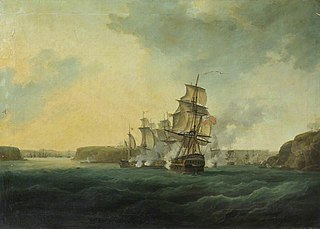Related Research Articles
Sixteen different ships of the British Royal Navy have been named HMS Greyhound, after the greyhound, a breed of dog notable for its speed.

HMS Agincourt was a 64-gun third-rate ship of the line of the Royal Navy, launched on 23 July 1796 at Blackwall Yard, London. The Admiralty bought her on the stocks from the East India Company in 1796, who had called her Earl Talbot.
Two ships of the Royal Navy have borne the name HMS Nabob, an earlier spelling for Nawab, a deputy provincial governor in the Mughal Empire. not the current usage which refers to an Anglo-Indian term for a conspicuously wealthy man who made his fortune in the Orient, especially in the Indian subcontinent.
Three Royal Navy ships have borne the name HMS Lutin or Lutine, Lutine being French for "the tease" or "tormentress" or more literally "imp", and Lutine the feminine:

HMS Magnanime was a 64-gun third-rate ship of the line of the Royal Navy, launched on 14 October 1780 at Deptford Dockyard. She belonged to the Intrepid-class designed by Sir John Williams and later was razeed into a 44 gun frigate.

HMS Montague was a 74-gun third rate ship of the line of the Royal Navy, launched on 28 August 1779 at Chatham Dockyard.
Several ships of the Royal Navy have been named HMS Egmont:
Thirty-nine vessels of the Royal Navy and its predecessors have borne the name Swallow, as has one dockyard craft, one naval vessel of the British East India Company, and at least two revenue cutters, all after the bird, the Swallow:
Eight ships of the Royal Navy have borne the name HMS Espiegle
Seven ships of the Royal Navy have borne the name HMS Strombolo, or HMS Stromboli, after the volcano Stromboli, in Italy:
Four ships of the Royal Navy have been named HMS Louisa:
Three ships of the Royal Navy have borne the name HMS Chub, or alternatively HMS Chubb, a name given to several types of fish, many in the family Cyprinidae:
HMS Resource was a 28-gun Enterprise-class sixth-rate frigate of the Royal Navy. She was launched in 1778 and sold for breaking up in 1816.

The Albacore-class gunboat, also known as "Crimean gunboat", was a class of 98 gunboats built for the Royal Navy in 1855 and 1856 for use in the 1853-1856 Crimean War. The design of the class, by W. H. Walker, was approved on 18 April 1855. The first vessels were ordered the same day, and 48 were on order by July; a second batch, which included Surly, were ordered in early October.
HMS Sultana was the mercantile Sprightly, which the Royal Navy purchased in June 1780. She served in the Channel and around Ireland before the Admiralty sold her in 1799.
HMS Negresse was a tartane that the French Navy requisitioned at Marseilles in March 1798 and used as an aviso in the Egyptian campaign. The Royal Navy captured her in 1799 and took her into service. She participated in the defense at the siege of Acre later that year and in 1801 at the landing of British troops at Aboukir Bay. The Royal Navy sold her in 1802.
The French schooner Découverte was a French Navy vessel launched in 1800. The British captured her at Santo Domingo in 1803 and took her into service as HMS Decouverte. She was decommissioned in January 1806 and sold in 1808.
The French gunboat Légère was a felucca that the French Navy commissioned in August 1794 at Toulon. The Royal Navy captured her in September 1798 and took her into service as HMS Legere. The Royal Navy disposed of her by 1803.
Six ships of the Royal Navy were named Lucifer:-
HMS Berbice was a schooner, initially built for use as a merchant ship, that the Royal Navy purchased in the West Indies in 1780. Her most prominent service was as a naval tender to HMS Adamant, the flagship of Sir Richard Hughes in the Leeward Islands Station. She was formerly commissioned in July 1781, and from 1782 to 1783 she was commanded by Lieutenant Thomas Boulden Thompson. On 23 February 1782, naval records indicate that she was at English Harbour, in need of crewmen but otherwise ready for active duty.
References
- Colledge, J. J.; Warlow, Ben (2006) [1969]. Ships of the Royal Navy: The Complete Record of all Fighting Ships of the Royal Navy (Rev. ed.). London: Chatham Publishing. ISBN 978-1-86176-281-8.
- Long, William H. (1895). Medals of the British navy and how they were won: with a list of those officers, who for their gallant conduct were granted honorary swords and plate by the Committee of the Patriotic Fund. London: Norie & Wilson.
- Winfield, Rif (2007). British Warships in the Age of Sail 1714–1792: Design, Construction, Careers and Fates. Seaforth. ISBN 978-1844157006.
- Winfield, Rif (2008). British Warships in the Age of Sail 1793–1817: Design, Construction, Careers and Fates. Seaforth. ISBN 978-1-86176-246-7.
This article includes data released under a Creative Commons Attribution-ShareAlike 3.0 Unported UK: England & Wales Licence, by the National Maritime Museum, as part of the Warship Histories project.